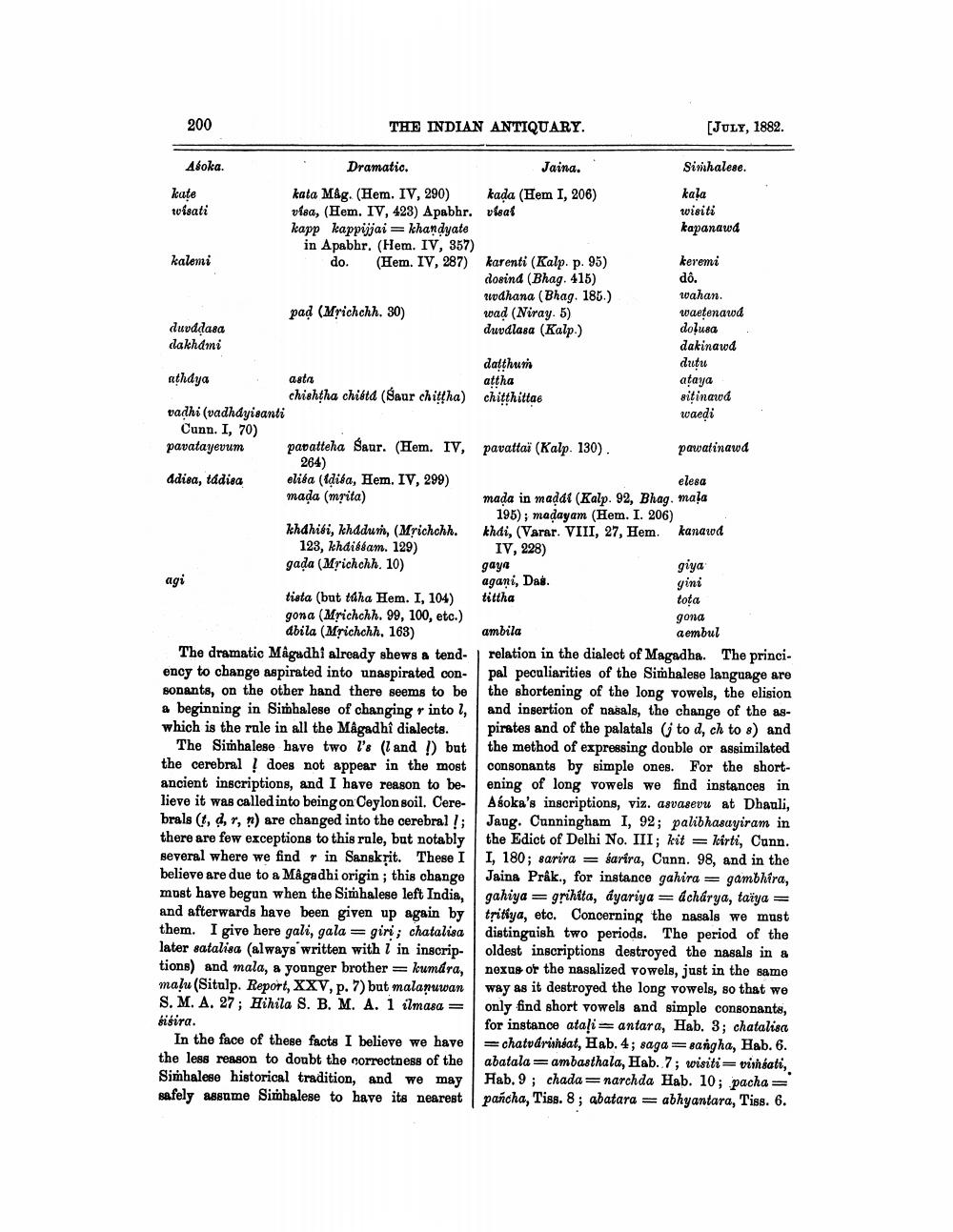________________
200
Asoka.
kate
wisati
kalemi
duváḍasa dakhdmi
agi
athaya
vadhi (vadhdyisanti Cunn. I, 70) pavatayevum
ádisa, tádisa
THE INDIAN ANTIQUARY.
Dramatic.
kata Mag. (Hem. IV, 290) visa, (Hem. IV, 423) Apabhr. kapp kappijjai khandyate in Apabhr. (Hem. IV, 357) do. (Hem. IV, 287)
pad (Mrichchh. 30)
datthum
asta
attha
chishtha chiétá (Saur chittha) chitthittae
elisa (disa, Hem. IV, 299) mada (mrita)
pavatteha Saur. (Hem. IV, pavattaï (Kalp. 130).
264)
khahibi, khddum, (Mrichchh. 123, khdissam. 129) gada (Mrichchh. 10)
Jaina.
kada (Hem I, 206) visat
tista (but túha Hem. I, 104) gona (Mrichchh. 99, 100, etc.) dbila (Mrichchh. 163)
karenti (Kalp. p. 95) dosind (Bhag. 415) uvdhana (Bhag. 185.) waḍ (Niray. 5) duválasa (Kalp.)
In the face of these facts I believe we have the less reason to doubt the correctness of the Simhalese historical tradition, and we may safely assume Simhalese to have its nearest
gaya agani, Das. tittha
The dramatic Magadhi already shews a tendency to change aspirated into unaspirated consonants, on the other hand there seems to be a beginning in Simhalese of changing r into l, which is the rule in all the Mâgadhî dialects.
The Simhalese have two 's (land) but the cerebral does not appear in the most ancient inscriptions, and I have reason to believe it was called into being on Ceylon soil. Cerebrals (t, d, r, n) are changed into the cerebral !; there are few exceptions to this rule, but notably several where we find r in Sanskrit. These II, believe are due to a Mâgadhi origin; this change must have begun when the Simhalese left India, and afterwards have been given up again by them. I give here gali, gala giri; chatalisa later satalisa (always written with 7 in inscriptions) and mala, a younger brother = kumára, malu (Sitalp. Report, XXV, p. 7) but malanuwan S. M. A. 27; Hihila S. B. M. A. 1 ilmasa= sisira.
=
[JULY, 1882.
Simhalese.
kala
wisiti
kepanovd
keremi
dô.
wahan.
waetenawa
dolusa
dakinawa
elesa
mada in maddi (Kalp. 92, Bhag. mala 195); maḍayam (Hem. I. 206) khái, (Varar. VIII, 27, Hem. IV, 228)
kanawa
dutu
aṭaya Bitinawa
waedi
pawatinawa
giya
gini
tota
gona
aembul
ambila
relation in the dialect of Magadha. The principal peculiarities of the Simhalese language are the shortening of the long vowels, the elision and insertion of nasals, the change of the aspirates and of the palatals (j to d, ch to 8) and the method of expressing double or assimilated consonants by simple ones. For the shortening of long vowels we find instances in Aśoka's inscriptions, viz. asvasevu at Dhauli, Jaug. Cunningham I, 92; palibhasayiram in the Edict of Delhi No. III; kit kirti, Cunn. 180; sarira sarira, Cunn. 98, and in the Jaina Prâk., for instance gahira = gambhira, gahiya grihita, áyariya acharya, taiya = tritiya, etc. Concerning the nasals we must distinguish two periods. The period of the oldest inscriptions destroyed the nasals in a nexus or the nasalized vowels, just in the same way as it destroyed the long vowels, so that we only find short vowels and simple consonants, for instance atali antara, Hab. 3; chatalisa
=
chatvarinéat, Hab. 4; saga sangha, Hab. 6. abatala ambasthala, Hab. 7; wisiti=visati, Hab. 9; chadanarchda Hab. 10; pacha= pañcha, Tiss. 8; abatara abhyantara, Tiss. 6.




